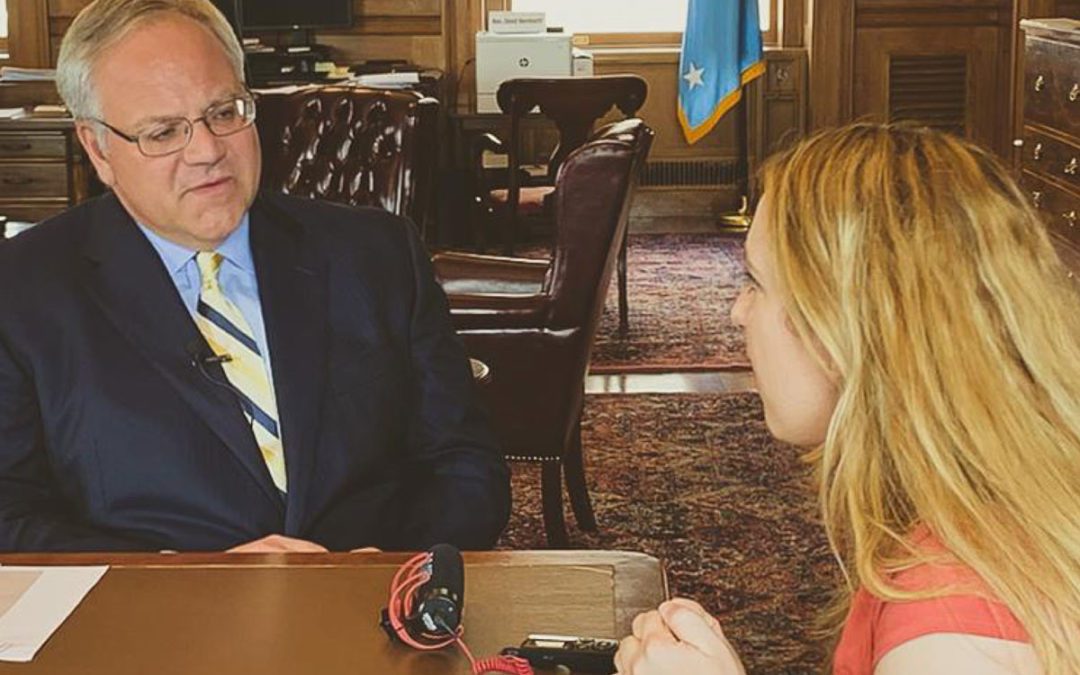Bernhardt, beaming with pride, tells me the massive antlers belonged to the moose he harvested in Alaska’s Yukon-Charley Rivers National Preserve.
It’s rare to encounter individuals, let alone Cabinet Members, who openly talk about this in “The Swamp.”
But for the Rifle, Colorado native, hunting and fishing are in his blood. He credits his grandpa for hooking him on fly fishing at an early age. From there, he was soon drawn to shooting sports and hunting.
The December exit of his boss, Ryan Zinke, presented Mr. Bernhardt an opportunity to become the next Secretary of the Interior.
This past February, President Trump formally nominated him to succeed Zinke. In addition to serving as Deputy Secretary of the Interior, he held various roles in the same department in the Bush administration and served as a member of Virginia’s Department of Game and Inland Fisheries (VDGIF) Board of Directors.
Despite a contentious confirmation process, the U.S. Senate approved his nomination by a 56-41 vote on April 11th, 2019.
For the 53rd Interior Secretary, he wants to bring together different stakeholders to advance a collaborative approach to conservation stewardship.
Bernhardt’s Goals at Interior
On March 3rd, 1849, Interior was established to address the country’s internal affairs. Initial responsibilities ranged from building Washington, D.C.’s water system to Indian affairs to managing public parks.
Bernhardt’s agency currently employs 69,000 people and is tasked with overseeing 483 million acres of public land, or 75% of all federal land, across all 50 states and U.S. territories. It also boasts nine bureaus—including the Bureau of Land Management (BLM), National Park Service (NPS), and U.S. Fish and Wildlife Service (USFWS).
He tells me it was a top priority to first reform the Federal Land Policy and Management Act of 1976 through Secretarial Order 3373, which now permits BLM to weigh public access considerations for outdoor activities like fishing, hunting, and hiking.
“When I got here, one of the first things I said is, we will ensure one of the most important things we can do as the land management agency is ensure that hunters, fishers, recreationists of all sorts, have an opportunity to access that land,” he said.
“It’s very important that we ensure that there’s public access and we facilitate public access. I’ve issued an order that says for any piece of property that we’re looking at exchanging, acquiring or disposing of, we need to think about what is the impact…on that public access.”
A Return to Multi-Use and Sustainable Yield Public Lands Management
Many Bernhardt critics believe his unique management style will destroy natural resources and kill wildlife.
He understands a multi-use approach to public lands management will effectively promote true conservation policies.
“There are communities, entire communities, that have been built throughout the West that are dependent on the activities that take place on the public lands for their economic future—their economic hopes,” he noted.
“My belief is those activities can take place in harmony with sound management, with sustainable programs and smart regulation.”
Congress mandates BLM lands for multiple uses including ranching, livestock grazing, timber, energy development, and outdoor recreation. Under the Trump administration, the agency’s goals are listed as “energy independence, shared conservation stewardship, keeping our borders safe, putting Americans back to work, and serving the American family.”
The bureau, which is slated to move from D.C. to Grand Junction, CO soon, now wants to be a good neighbor and help restore trust with Western stakeholders.
Addressing Declining Hunting Numbers
The dismal findings of the 2016 National Survey of Fishing, Hunting, and Wildlife-Associated Recreation report haven’t gone unnoticed by Bernhardt.
The report showed a steep decline in hunting participation, from 13.6 million to 11.5 million, during the 2011-2016 period. Fishing, in contrast, saw an 8.2 percent growth in overall participation during the same time frame— from 33.1 million to 35.8 million.
Given the alarming results, the secretary has prioritized efforts to enhance hunting and fishing access for Americans. Recently, he announced expanded opportunities on 1.4 million acres across 74 national wildlife refuges (NWR) and 15 hatcheries of the National Fish Hatchery System public lands managed by USFWS.
He credits the North American Model of Wildlife Conservation as the seminal success story for wildlife conservation globally.
There are three major threats to that model, he says. They are demographic changes from rural to urban areas, lack of public access, and confusion over complex regulatory requirements to pursue these activities.
“People occasionally forget —we have not forgotten— that it is the hunters and anglers who first recognized and came up with a program that said, hey, we need to preserve these natural resources and these species,” he said.
“The creation of things like the duck stamp and other activities, where hunters and anglers have actually paid fees that have gone to support ecosystems, will facilitate these particular species.”
He also praised recreational shooters, who pay the bulk of conservation funding, for their contributions.
Excise taxes placed on licenses, firearms, fishing tackle, and archery are collected by Interior under the Pittman-Robertson Act of 1937. A portion of the earnings collected are then distributed to all 50 state wildlife agencies to be used for habitat management, species conservation, hunter education programs, and wildlife surveys. It’s estimated recreational shooters, hunters, and anglers pay 60% of total conservation funding in this country.

Shot of downtown Washington, D.C., from the Department of Interior rooftop.
States to Lead Fish and Wildlife Management Authority on Department Lands
Last September, former Interior Secretary Zinke issued a memo instructing all nine bureau directors to assess whether or not hunting and fishing regulations on department lands greatly contrast state regulations.
The memo reads, “The Department recognizes States as the first-line authorities for fish and wildlife management and hereby expresses its commitment to defer to the States in this regard except as otherwise required by Federal law.”
It says all 50 state governments boast “extensive capacities and competencies” to act as “trustees for fish and wildlife species resident in the respective States.”
His successor agrees.
“We need to make sure that our regulations closely align with state regulations because that makes things easier for people,” said Bernhardt. “If you need a lawyer to figure out if you’re going to hunt on federal or state property, that’s awkward.”
“We’ve also created specific positions in the Fish and Wildlife Service— that are hunting and fishing chiefs—that are looking for opportunities to align our regulations to ensure access. And we’ve gone through a massive program of looking at each refuge, refuge by refuge, and asking, can we expand public participation? Can we make our regulations look more like the state regulations? We’ve done that for the first time ever— completely across the Service landholdings and we’ve even opened up hatcheries.”
Managing Recovered Wildlife Species Shouldn’t Be Controversial
Secretary Bernhardt believes species that have recovered under the Endangered Species Act (ESA) of 1973 can be managed without decimating their overall population.
Since its inception, the ESA has prevented domestic flora and fauna from going extinct. However, only 54 of 1,661 species currently listed— roughly three percent—have successfully recovered.
Federal lawmakers hope to modernize the law soon. Why? They argue it’s been weaponized by animal rights and environmental activists at the expense of recovered species like the Lower 48 gray wolf.
“In the case of the gray wolf, there has been a lot of controversy over the years,” Berhardt said. “The reality is that when our scientists look at that species they fundamentally believe that that species is recovered. The wolf population is expanding and thriving in various areas in the United States, and that is just simply a reality.”
“There is always controversy and consternation when you look at these apex predators. The impact that they have on wildlife, the impact that they have on farmers. There is a significant impact. At the same time, we want them to succeed and be recovered. In the case of the wolves, we believe they are.”
Bernhardt says a species getting off the list should be a testament to the law’s effectiveness. Delisting species and returning management to the states, he adds, isn’t a controversial notion.
Congress Needs to Tackle National Park Service Backlog
A great concern for Secretary Bernhardt is the $12 billion deferred maintenance backlog plaguing the NPS.
“This administration is very committed to improving the infrastructure at our nation’s parks,” he said. “If you were to go to our national parks, what you would see is we have buildings that are crumbling. We have roads that are in serious disrepair. We have parking lots that were built at a time when visitation was much less than it is today.”
Bernhardt tells me his agency proposed the Public Lands Infrastructure Fund to address these infrastructure challenges. He says it’s long overdue for Congress to resolve this problem.
“Congress seems interested in working with us, so we’re hoping that will be something that we can work on in a bipartisan way together, to have a sound success and, ultimately, reducing this massive backlog that currently exists,” he added.
At the time of this writing, the bipartisan Restore Our Parks and Public Lands Act—touted as a legislative solution—awaits a full vote in the House of Representatives.
Mr. Bernhardt and his agency admit there are challenges to carrying out their goals. However, they remain optimistic and are ready to meet them head-on.
Sportsmen and women can appreciate having an ally like him at the helm of the Department of Interior today.
To learn more about Secretary Bernhardt and the Interior Department, visit their website and follow them on Facebook, Instagram, and Twitter.

